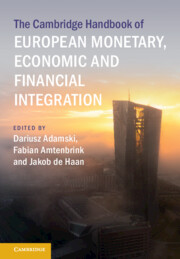Book contents
- The Cambridge Handbook of European Monetary, Economic and Financial Integration
- The Cambridge Handbook of European Monetary, Economic and Financial Integration
- Copyright page
- Contents
- Contributors
- Introduction
- Part I The Economic and Monetary Union
- Part II The Monetary Dimension
- 9 The Overburdened Monetary Policy Mandate of the ECB
- 10 Government Bond Buying by the European Central Bank
- 11 ECB Monetary Policies
- 12 From Market to Green Economics
- 13 The Politics of Monetary Union and the Democratic Legitimacy of the ECB as a Strategic Actor
- 14 How Can Courts Contribute to Accountability in EU Monetary Policy?
- Part III The Economic and Fiscal Dimensions
- Part IV Financial Integration
- Index
- References
13 - The Politics of Monetary Union and the Democratic Legitimacy of the ECB as a Strategic Actor
from Part II - The Monetary Dimension
Published online by Cambridge University Press: 28 September 2023
- The Cambridge Handbook of European Monetary, Economic and Financial Integration
- The Cambridge Handbook of European Monetary, Economic and Financial Integration
- Copyright page
- Contents
- Contributors
- Introduction
- Part I The Economic and Monetary Union
- Part II The Monetary Dimension
- 9 The Overburdened Monetary Policy Mandate of the ECB
- 10 Government Bond Buying by the European Central Bank
- 11 ECB Monetary Policies
- 12 From Market to Green Economics
- 13 The Politics of Monetary Union and the Democratic Legitimacy of the ECB as a Strategic Actor
- 14 How Can Courts Contribute to Accountability in EU Monetary Policy?
- Part III The Economic and Fiscal Dimensions
- Part IV Financial Integration
- Index
- References
Summary
This chapter contends that if we want to make sense of the politics of Europe’s monetary union, we need to focus on the democratic legitimacy of the European Central Bank as a strategic political actor. The chapter departs from common distinctions in the literature between input, output, and throughput legitimacy and instead seeks to analyse how the ECB has navigated these dimensions strategically. To do so, it develops a theory of legitimation strategies based on distinctions between normal and crisis times and between a central bank’s organizational and systemic interests. The theory is assessed through a discussion of the first two decades of ECB monetary policy-making – from the inception of Europe’s Economic and Monetary Union until the outbreak of the COVID-19 crisis – and through a comparison of the ECB’s democratic legitimacy with that of other major central banks.
- Type
- Chapter
- Information
- Publisher: Cambridge University PressPrint publication year: 2023
References
- 1
- Cited by

